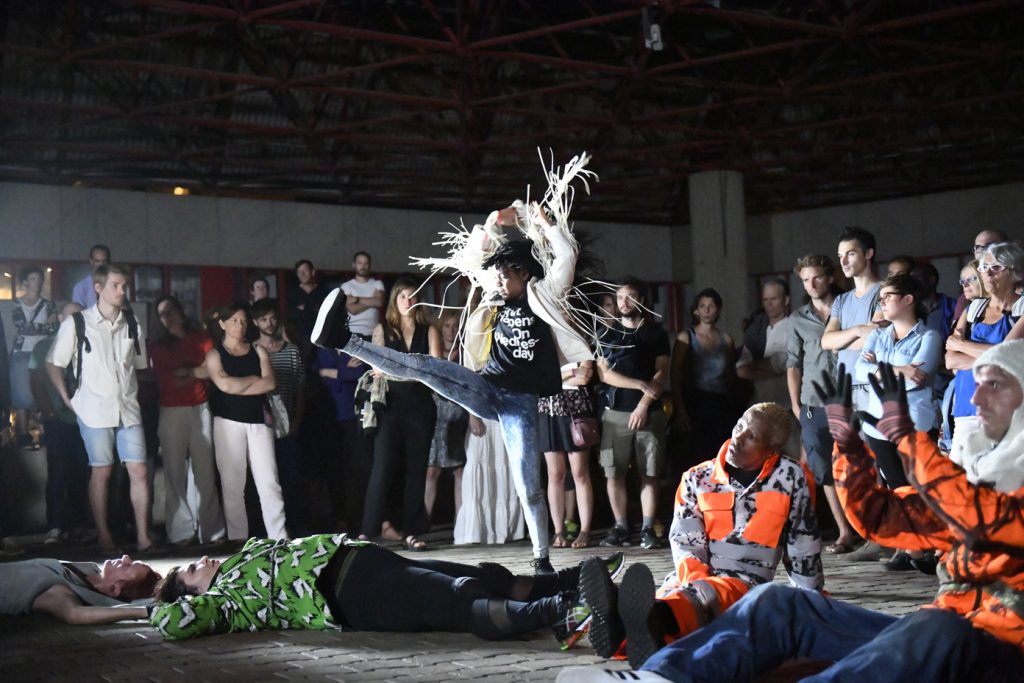Op het Anton de Komplein is het minder gezellig dan op het dak van Parking 58 in Brussel, waar ik danse de nuit eerder zag. Boven Zuid-Oost is de maan verstopt achter een dikke nevel, voelt het plein groot en leeg aan zo zonder de markt. De voorstelling van choreograaf Boris Charmatz/Musée de la Danse, ook vandaag en morgen nog te zien in de Bijlmer tijdens het Holland Festival, lijkt eenvoudig. Dansers zeggen letterlijk wat ze doen, wat hen bezighoudt, ze vertellen aan een stuk door. Hun bewegingen geven die woorden nog eens extra dynamiek. Het lijkt een beetje op hoe kleine kinderen spelen, geluiden makend, morfend: met je hand een autootje doen, de bocht worden en dan met je hele lijf de botsing doen. Maar er spreekt ook een enorme behoefte uit. Om te delen. Om gehoord te worden.
een rat die aan testikels knabbelt
Geweld speelt een grote rol in de teksten, maar ook in de gestes van de dansers. Er wordt uitgebreid stil gestaan bij de moordaanslag op de redactie van Charlie Hebdo in Parijs, januari 2015. Maar ook de wrede gestes die in cartoons voorkomen, zoals een rat die aan testikels knabbelt, worden uitgesponnen en nagedaan. De dansers verplaatsen zich voortdurend en het geheel heeft iets vrolijks, energieks, alsof er van pijn en lijden geen sprake is.
Door de nadruk van de teksten op geweld ‘elders’, vergeet je als toeschouwer dat de dansers behoorlijk wild omgaan met hun eigen lijf, aan de voeten van de toeschouwers, die soms wat onwennig om hen heen staan. Deze kwetsbaarheid wordt door Charmatz nergens uitgespeeld. Nooit wordt een danser angstig, nooit lijkt er iemand vermoeid. Het drama, de gevoelens, de gedachten, ze worden alleen verteld.
Monument voor de doden
De teksten zijn in het Engels, maar de accenten vol verkeerde klemtónen, en het hoge tempo waarin de teksten er uitkomen – op de maat van de bewegingen – maken het soms moeilijk om alles tot in detail te volgen. Het maakt dat je als toeschouwer toch ook een beetje een buitenstaander blijft, ondanks het engagement van de dansers. Daar staat tegenover dat het er allemaal heel direct uitkomt. Geen geactreutel, geen pretenties. Dat maakt sommige scènes extra cru, bijvoorbeeld wanneer een vrouw in haar kruis gevat wordt en rondgesleept aan haar haren door collega-dansers. Het is een vervreemdende tegenstelling die zo ontstaat, tussen de liefdevolle energieke manier waarom de dansers onderling en met het publiek omgaan, en de scènes die ze ondertussen opvoeren.
Dan heeft ineens een hele ketting van dansers elkaars kruis gevat. Danseres Marlène Saldana citeert Patrick Pelloux, lid van de redactie van Charlie Hebdo, die als eerste de burelen binnenstapte na de gruwelijke aanslag. Een wonderlijke stilte breekt los. Zonder nadruk of opsmuk, als gevallenen liggen de dansers daar stomweg. Zo wordt in korte tijd een verkrachtings-scène een monument voor slachtoffers, voor helden van het vrije woord of de vrije tekening. Jolie Ngemi, de danseres met de witte leren cowboyjas, springt op en danst een wederopstandingsdansje. “Koekoe”, zegt ze lief tegen een mededanser op de grond, “wakker worden”.
Doffe woede
Het meest idiote gedeelte van de voorstelling bestaat uit een lange lijst van film- en andere sterren, die in banale en compromitterende scènes zijn gestopt. “Meryl Streep Fucking. Nathalie Portman fucking. Penelope Cruz giving a blowjob on the back of a Honda 4.” Het komt uit een tekst van Tim Etchells, die Starfucker heet. Sommige scènes herken je, Hollywood zit vol geweld, vol sex, al krijgen we het natuurlijk nooit zo heel precies te zien. De realiteit wordt ons ook door Charmatz niet ingepeperd, dat zou nog meer drama, voyeurisme en fictie opleveren. Charmatz geeft alleen de aanzet van een vorm, het begin van inleving. Je zou het cartoonesk kunnen noemen, een paar rake lijnen en de juiste slagzin.
In de contouren tekent zich een doffe woede af, van mensen die gehoord willen worden, die via shock and awe aandacht vragen. Grappig genoeg geldt die strategie evengoed voor cartoonisten als voor de jonge aanslagplegers, die de hoofdsteden van Europa op dit moment onveilig maken. “Welkom in deze ruimte, welkom in mijn hoofd”. Uiteindelijk lijkt danse de nuit aandacht te vragen voor ieders vermogen tot fantasie en ieders verlangen om gehoord te worden.

Wanhoop
Charmatz weet behendig een vat vol tegenstellingen te enscèneren. Hij brengt het publiek een beetje in de situatie die outsiders gewoon zijn. De taal niet helemaal verstaan, de omgangsvormen nog moeten leren. danse de nuit herinnert ons aan het feit dat de werkelijkheid veel te heftig is om in fictie om te zetten. Maar ook dat het geweld ergens vandaan komt, dat er een basis van menselijkheid is, die wanneer gefnuikt, tot groot geweld kan leiden. Het zijn eigenlijk clichés, maar Charmatz enscèneert ze op een indringende manier, indirect en vol verborgen wanhoop.
